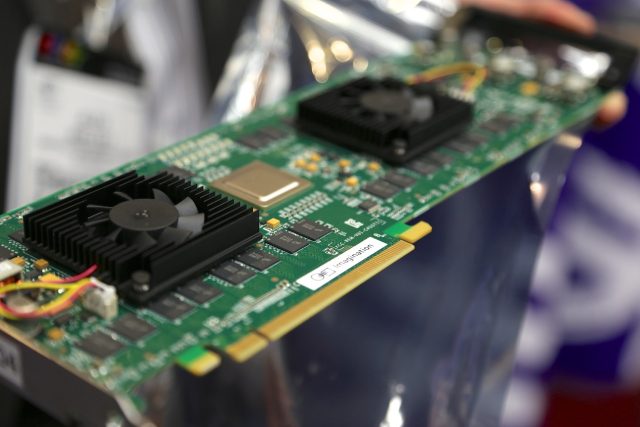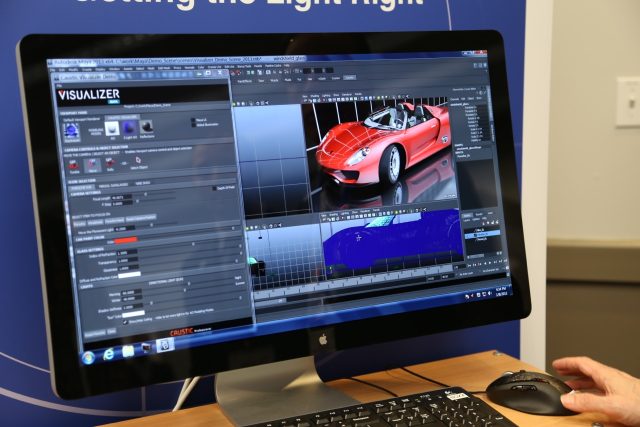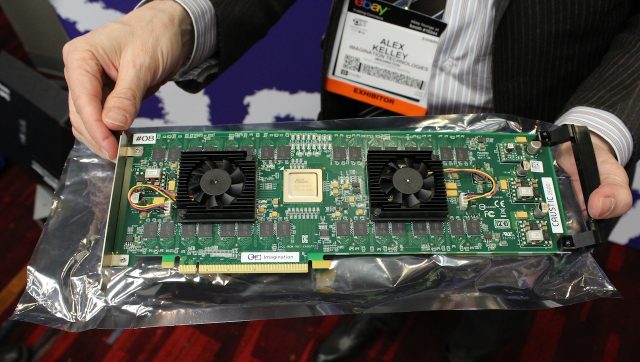
Imagination Technologies is one of those companies simultaneously ubiquitous and invisible. Its PowerVR graphics processors drive high-profile electronics like Sony's PlayStation Vita, Apple's iPhones and iPads, and any number of past-and-present smartphones, tablets, and laptops. But you'd probably be hard-pressed to find anyone outside of technology circles who actually knows the name.
While most of our coverage of Imagination is driven by these mobile GPU designs, the company also has its eyes on other markets. We stopped by its CES meeting room to get a glimpse at the Series6 PowerVR GPUs that are going to begin making their way into consumer products this year, but the company was also showing off something else: a pair of workstation-class PCI Express add-in cards that allow 3D rendering programs to do something called ray tracing in real time. This is something hardware developers have been chasing (and we've been covering) for many years, so we took some time to see the hardware in action.
What is ray tracing, and why do I want it?

To put it as simply as possible, ray tracing is used to render light and its interactions with objects. A ray tracing algorithm will track rays of light from a light source to an object. Once the light hits that object, the algorithm can account for how much light will be absorbed by the surface, how much will be reflected or refracted by the surface, and how that reflected and refracted light interacts with other surfaces, among other things.
The end result is an image with very accurate, realistic light. There are plenty of reasons this would be useful—better-looking 3D games, movies, and computer-generated imagery on the entertainment side, faster and more lifelike CAD renderings on the professional side—but ray tracing has typically been too intensive a task to do in real time. It's a workload that is ill-suited to even the most powerful of today's graphics processors. Intel briefly promised real-time ray tracing would become an affordable reality in its discrete graphics card, codenamed Larrabee, but that initiative was axed before any real hardware could see the light of day.
This is where Caustic comes in. The company has been talking up its real-time ray tracing technology since it was a scrappy young startup back in 2009, and an acquisition by Imagination in 2010 has only increased its ambition. Its first commercially available real-time ray tracing cards go on sale this month, but as we'll discuss, the company has even bigger plans for the technology in the future.
The Caustic R2500: Work smarter, not harder

The faster of the two cards, the $1,500 Caustic R2500, is physically large, but the actual hardware driving it is much less powerful (and power-hungry) than what's found in a high-end workstation graphics card. Two of Caustic's ray tracing units, or RTUs, are located under the card's small cooling fans. Each of them has 8GB of memory dedicated to it for a total of 16GB on the entire card.
This sky-high amount of memory, which far exceeds the amount available on most graphics cards (and even many computers), is the highest-end spec the card has. The heavy lifting is done by silicon that seems ancient by today's standards: the RTUs are manufactured on a 90nm process and use DDR2 memory, both of which were cutting-edge circa 2005 or so. Despite this, the card still requires a relatively small amount of power. While its peak power consumption is rated at 60 watts, we were told that realistically it maxes out at about 40 watts—much less than a modern high-end (or even a low-end) graphics card, and well under the amount that would require the card to have a separate power plug.
For those with less cash, the $800 Caustic R2100 offers one RTU paired with 4GB of RAM and consumes about half the power of the R2500, with a peak power consumption of between 30 and 40 watts—because it has half the RTUs and a quarter of the RAM, its rendering speed should be less than half that of the R2500, though we weren't able to see the low-end card in action to be sure.
The cutting edge secret sauce of the R2500 isn't in its raw power, then, but the patented algorithms that Imagination and Caustic are using to solve the real-time ray tracing problem.
"The way the algorithm works, it turns ray tracing from a high-performance compute, memory-intensive problem to one that's more like a database problem," Imagination Technologies Director of Product Management Michael Kaplan told Ars. "It's highly optimized. We can store about 120 million triangles on that card."
The end result is easier to show than it is to describe—Imagination Technologies Director of Business Development Alex Kelley was on hand to give us a demonstration of just what the Caustic R2500 was capable of.
The Caustic card enables CAD programs to realistically render light in real time and allows designers to change things like the angle of a windshield or the color of the paint without having to wait for the computer to re-render the image every time they make a change.
"You're getting all of this information very early on in the design process, where normally you'd have to sit, hit the render button, wait, and then move on," said Kelley.
Developers will have to build support for the Caustic cards into their applications, but Imagination is providing tools to make that as simple as possible. OpenRL is the low-level API, roughly equivalent to OpenGL on the graphics side, while the company's Brazil SDK is the high-level toolkit that developers can use to implement Caustic support in their software. The demo seen above was given in Autodesk Maya, for which a plugin is already available, and McNeel's Rhino 5 CAD software will also support the card. Imagination is working with several other vendors to implement support, but it couldn't give us any more specifics as of this writing.
Again, there's also a lower-end version of the card for those with less cash (the $800 Caustic R2100 mentioned above). Everything we saw in this demo was based on the performance of the R2500, but smaller shops will definitely appreciate the cheaper option.
An ambitious future: Real-time ray tracing in a tablet?
We came away impressed by the technology in Caustic's add-in card, but the reality is it's difficult to sell an extra add-in card that isn't a GPU these days—just ask Ageia, whose dedicated physics processing add-in cards went pretty much nowhere before Nvidia snapped them up and integrated PhysX support into its GeForce cards. The Caustic cards will appeal to people in the high-end, high-margin workstation market, but by Imagination's own admission that market is quite small.
The Caustic technology's path to the mass market will be similar: Imagination intends to integrate into future versions of its PowerVR GPUs. This isn't going to happen anytime soon—the Imagination representative gave us a tentative estimate of "four to five years" from now—but it may be that the phones and tablets of tomorrow will be capable of 3D rendering that is only now beginning to hit high-end workstations.
This would dovetail nicely with the way the industry is moving. Mobile devices are already getting more productive as they get more powerful, and the major hardware manufacturers seem determined to deliver devices that can be all things to all people—phones that can double as tablets, tablets that can double as laptops, and so on. By 2018, it's easy to imagine a tablet that can also do high-end CAD work, and if Imagination has its way, the Caustic ray tracing technology will be leading that charge.
reader comments
73